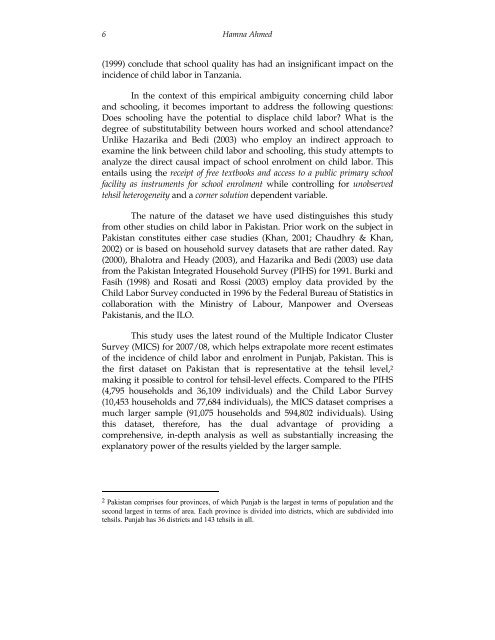The Impact of Public School Enrolment on Child Labor in Punjab ...
The Impact of Public School Enrolment on Child Labor in Punjab ...
The Impact of Public School Enrolment on Child Labor in Punjab ...
Create successful ePaper yourself
Turn your PDF publications into a flip-book with our unique Google optimized e-Paper software.
6Hamna Ahmed(1999) c<strong>on</strong>clude that school quality has had an <strong>in</strong>significant impact <strong>on</strong> the<strong>in</strong>cidence <str<strong>on</strong>g>of</str<strong>on</strong>g> child labor <strong>in</strong> Tanzania.In the c<strong>on</strong>text <str<strong>on</strong>g>of</str<strong>on</strong>g> this empirical ambiguity c<strong>on</strong>cern<strong>in</strong>g child laborand school<strong>in</strong>g, it becomes important to address the follow<strong>in</strong>g questi<strong>on</strong>s:Does school<strong>in</strong>g have the potential to displace child labor? What is thedegree <str<strong>on</strong>g>of</str<strong>on</strong>g> substitutability between hours worked and school attendance?Unlike Hazarika and Bedi (2003) who employ an <strong>in</strong>direct approach toexam<strong>in</strong>e the l<strong>in</strong>k between child labor and school<strong>in</strong>g, this study attempts toanalyze the direct causal impact <str<strong>on</strong>g>of</str<strong>on</strong>g> school enrolment <strong>on</strong> child labor. Thisentails us<strong>in</strong>g the receipt <str<strong>on</strong>g>of</str<strong>on</strong>g> free textbooks and access to a public primary schoolfacility as <strong>in</strong>struments for school enrolment while c<strong>on</strong>troll<strong>in</strong>g for unobservedtehsil heterogeneity and a corner soluti<strong>on</strong> dependent variable.<str<strong>on</strong>g>The</str<strong>on</strong>g> nature <str<strong>on</strong>g>of</str<strong>on</strong>g> the dataset we have used dist<strong>in</strong>guishes this studyfrom other studies <strong>on</strong> child labor <strong>in</strong> Pakistan. Prior work <strong>on</strong> the subject <strong>in</strong>Pakistan c<strong>on</strong>stitutes either case studies (Khan, 2001; Chaudhry & Khan,2002) or is based <strong>on</strong> household survey datasets that are rather dated. Ray(2000), Bhalotra and Heady (2003), and Hazarika and Bedi (2003) use datafrom the Pakistan Integrated Household Survey (PIHS) for 1991. Burki andFasih (1998) and Rosati and Rossi (2003) employ data provided by the<strong>Child</strong> <strong>Labor</strong> Survey c<strong>on</strong>ducted <strong>in</strong> 1996 by the Federal Bureau <str<strong>on</strong>g>of</str<strong>on</strong>g> Statistics <strong>in</strong>collaborati<strong>on</strong> with the M<strong>in</strong>istry <str<strong>on</strong>g>of</str<strong>on</strong>g> Labour, Manpower and OverseasPakistanis, and the ILO.This study uses the latest round <str<strong>on</strong>g>of</str<strong>on</strong>g> the Multiple Indicator ClusterSurvey (MICS) for 2007/08, which helps extrapolate more recent estimates<str<strong>on</strong>g>of</str<strong>on</strong>g> the <strong>in</strong>cidence <str<strong>on</strong>g>of</str<strong>on</strong>g> child labor and enrolment <strong>in</strong> <strong>Punjab</strong>, Pakistan. This isthe first dataset <strong>on</strong> Pakistan that is representative at the tehsil level, 2mak<strong>in</strong>g it possible to c<strong>on</strong>trol for tehsil-level effects. Compared to the PIHS(4,795 households and 36,109 <strong>in</strong>dividuals) and the <strong>Child</strong> <strong>Labor</strong> Survey(10,453 households and 77,684 <strong>in</strong>dividuals), the MICS dataset comprises amuch larger sample (91,075 households and 594,802 <strong>in</strong>dividuals). Us<strong>in</strong>gthis dataset, therefore, has the dual advantage <str<strong>on</strong>g>of</str<strong>on</strong>g> provid<strong>in</strong>g acomprehensive, <strong>in</strong>-depth analysis as well as substantially <strong>in</strong>creas<strong>in</strong>g theexplanatory power <str<strong>on</strong>g>of</str<strong>on</strong>g> the results yielded by the larger sample.2 Pakistan comprises four prov<strong>in</strong>ces, <str<strong>on</strong>g>of</str<strong>on</strong>g> which <strong>Punjab</strong> is the largest <strong>in</strong> terms <str<strong>on</strong>g>of</str<strong>on</strong>g> populati<strong>on</strong> and thesec<strong>on</strong>d largest <strong>in</strong> terms <str<strong>on</strong>g>of</str<strong>on</strong>g> area. Each prov<strong>in</strong>ce is divided <strong>in</strong>to districts, which are subdivided <strong>in</strong>totehsils. <strong>Punjab</strong> has 36 districts and 143 tehsils <strong>in</strong> all.
















